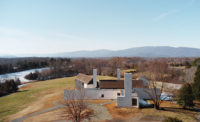With her appointment as curator of the second Istanbul Design Biennial, set to take place from October 18 to December 14, 2014, British-born, U.S.-based Zoë Ryan is helping shape one of the most important new design events even as she approaches her third year as chair and curator of architecture and design at the Art Institute of Chicago.
 |
| Photo © Kyle LaMere Zoë Ryan |
Launched in 2012 with curators Joseph Grima and Emre Arolat and director Özlem Yalım Özkaraoğlu, Istanbul’s first Design Biennial made a splash, yet left room to unite a broader segment of Turkey’s architecture community and further solidify the country’s role on the international design stage. Under new director Deniz Ova, Ryan has rallied a team, including associate curator Meredith Carruthers and Turkish design studio Superpool, that will help transform Istanbul’s Galata Greek Primary School into the epicenter of the event and develop a visual identity along with New York–based Project Projects. Ryan spoke with RECORD on the heels of announcing the 2014 biennial’s theme.
What perspective do you want to bring to the event?
This is an opportunity to get beyond the walls of a museum and do a project in a different kind of space and use the city as a platform. I’m interested in the biennial showing the rest of the world what Turkey has to offer. This is a culturally savvy society whose members are working in all different ways, but there are few forums for them such as the biennial. We also want to rethink the Greek school and use it more as a hub. It’s on a busy public thoroughfare with multiple floors and a great rooftop. We’re going to have an active program of workshops, where every week different university groups have a pinup space where they can present their findings to each other and the general public. Often these biennials become so disparate. There are thousands of things going on throughout the city, but so few feel connected. We don’t want people to feel like they’re working in isolation.
Can you explain how you arrived at the theme of the biennial, "The Future Is Not What It Used To Be"? What does it mean?
At the museum I make the team revisit what has become the absolute truth of modern design and architecture and try to get us to think about the people who have been left out of those stories. This summer, I came across a quote from the poet Paul Valéry that said, to paraphrase, “The future is not what it used to be; neither is the past. Both are in need of reconstruction if we are to have a livable present.” I think of it as very optimistic. We can revisit those 20th-century ideas; we’ve come past moments like 2001: A Space Odyssey. We are living in that future now.
The biennial has issued an open call for design manifestos. What do you hope to accomplish with this format?
We think a manifesto can be a provocation, an object, a piece of furniture, or a building; it can be a system or a network.
Istanbul’s Taksim Square protests have thrust issues of public space into the spotlight in Turkey. This is an international event, but how has the political environment influenced your curatorial process?
The first time I went to Istanbul it was during the political protests, so the energy was really focused on that moment. We’re inspired by beautiful illustrations by a group called Architecture for All. They have been documenting the temporary libraries, medical facilities, and kids’ play spaces that became part of Gezi Park’s mini-city. Those have become inspirational for how you document projects from a time that was so fraught and that could have been lost. Those things become their own manifesto from a specific point in time. We have to take control of the negative impact we’re having on life. No day goes by without us hearing about some horrific incident, like the typhoon in the Philippines. These kinds of things are so tragic that you don’t know where to start, but there are people already making changes, and I think many of them are designers.
I do feel optimistic, hopefully not naively, that design can be an active change agent. Those [designers] are the people we’re hoping to highlight—but it’s not necessarily about who’s doing it. We’re hoping new collectives will be formed. People have come to us to ask if they can work on this in groups, and of course it’s the best possible outcome when you pool resources. For me, that’s what the biennial is really about.



Post a comment to this article
Report Abusive Comment